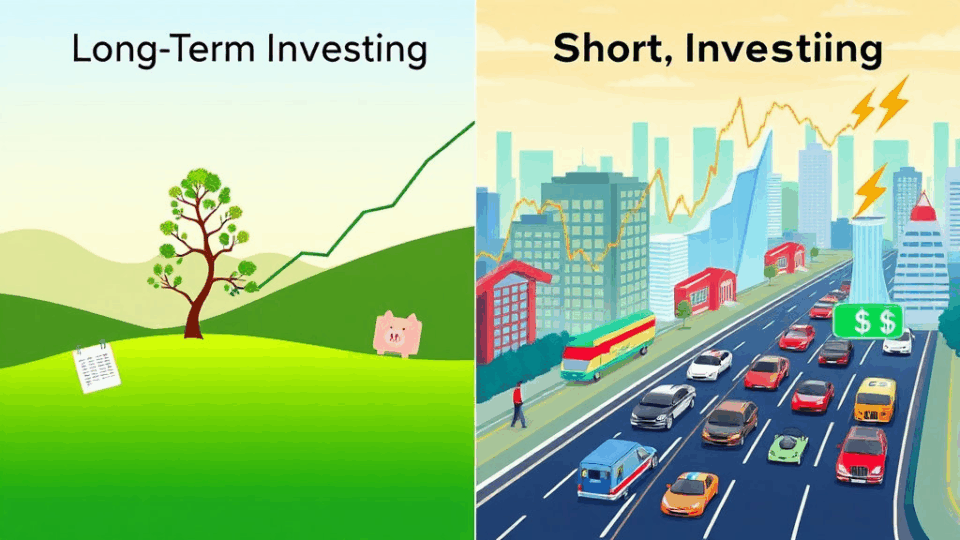
Long-Term vs. Short-Term Investing: Key Strategies Compared
What Is Long-Term Stock Investing?

Long-term stock investing is a strategy where investors buy and hold stocks for an extended period—typically five years or more—with the goal of building wealth gradually over time. Instead of reacting to short-term market fluctuations, long-term investors focus on the overall growth potential of a company and the power of compounding returns.
This approach is rooted in patience and discipline. By staying invested through market ups and downs, long-term investors can benefit from dividends, capital appreciation, and reduced transaction costs. It also helps avoid the emotional pitfalls of trying to time the market, which is notoriously difficult even for seasoned professionals.
Long-term investing is especially beneficial for retirement planning, college savings, or any financial goal that spans several years. It encourages thoughtful decision-making and aligns well with a buy-and-hold philosophy, which has historically proven successful for many investors.
In short, long-term stock investing is not about quick wins—it’s about consistent growth, financial security, and peace of mind. If you’re looking to build a solid financial future, this strategy might be a great place to start.
Understanding Short-Term Trading Tactics

Short-term trading can be an exciting and potentially rewarding way to engage with the stock market—especially for those who enjoy fast-paced decision-making and staying on top of market trends. Unlike long-term investing, which focuses on gradual growth over years, short-term trading involves buying and selling stocks (or other assets) within days, hours, or even minutes.
To succeed in short-term trading, it’s important to understand a few key tactics:
1. Technical Analysis: Short-term traders often rely on charts, patterns, and indicators like moving averages or RSI (Relative Strength Index) to make quick decisions. Learning how to read these tools can help you identify entry and exit points more effectively.
2. Risk Management: Because of the market’s volatility in the short term, managing risk is crucial. Many traders use stop-loss orders to limit potential losses and protect their capital.
3. Market News and Events: Staying informed about economic reports, earnings announcements, and geopolitical events can give you an edge. These factors can move markets quickly, so being aware helps you react in real time.
4. Discipline and Emotion Control: One of the biggest challenges in short-term trading is managing emotions. It’s easy to get caught up in the excitement or fear, but sticking to a strategy and avoiding impulsive decisions is key.
Short-term trading isn’t for everyone, but with the right knowledge, tools, and mindset, it can be a valuable part of your financial strategy. Always start small, practice with a demo account if possible, and never invest more than you can afford to lose. Happy trading!
Pros and Cons: Which Strategy Suits You?

When it comes to investing, choosing between long-term and short-term strategies can feel overwhelming. But don’t worry — understanding the pros and cons of each can help you make a decision that aligns with your financial goals, lifestyle, and risk tolerance.
Long-term investing involves holding assets like stocks, ETFs, or mutual funds for several years — often five years or more. The biggest advantage? Compound growth. Over time, your investments can grow significantly, especially if you reinvest dividends. Long-term investing also tends to be less stressful, as it avoids the daily market fluctuations that short-term traders often face. Plus, it usually comes with lower taxes, since long-term capital gains are taxed at a lower rate.
However, long-term investing requires patience and discipline. Markets can be volatile in the short run, and it can be tough to stay the course during downturns. Also, your money is tied up for a longer period, which might not suit everyone.
On the other hand, short-term investing focuses on quick gains — often within days, weeks, or months. This strategy can be exciting and potentially profitable if you have the time and knowledge to actively monitor the market. It also offers more liquidity, meaning you can access your money more quickly.
But short-term investing comes with higher risks. Market timing is difficult, and frequent trading can lead to higher taxes and transaction fees. It also demands more of your time and emotional energy.
So, which strategy suits you? If you’re looking for steady growth and can commit for the long haul, long-term investing might be your best bet. If you prefer more flexibility and are comfortable with higher risk, short-term trading could be a fit. Many investors find a balanced approach — combining both strategies — works best for their needs.
Remember, the best investment strategy is the one that matches your personal goals, timeline, and comfort with risk. Always take time to assess your situation before making a decision.
Key Factors in Choosing Your Investment Style

Choosing between long-term and short-term investing can feel overwhelming, especially if you’re just starting your financial journey. But don’t worry — understanding a few key factors can help you make a confident and informed decision that aligns with your goals, lifestyle, and risk tolerance.
1. Time Horizon: One of the most important factors is how long you plan to keep your money invested. If you’re saving for retirement or a child’s education years down the road, long-term investing may be the better fit. On the other hand, if you’re looking to grow your money quickly or capitalize on market trends, short-term investing might suit you more.
2. Risk Tolerance: Are you comfortable with market ups and downs? Long-term investors often ride out volatility, knowing that markets tend to grow over time. Short-term investors, however, need to be more agile and may face higher risks due to market fluctuations.
3. Financial Goals: Your investment style should reflect your personal goals. Long-term investing is ideal for building wealth steadily, while short-term strategies may be used for specific, near-term objectives like buying a car or funding a vacation.
4. Time Commitment: Consider how much time you can realistically dedicate to managing your investments. Short-term investing often requires more frequent monitoring and decision-making, while long-term investing allows for a more hands-off approach.
5. Emotional Discipline: Short-term investing can be emotionally taxing due to market volatility. If you’re someone who gets anxious with market swings, a long-term strategy might help you stay calm and focused.
By evaluating these factors honestly, you can choose an investment style that not only matches your financial situation but also brings peace of mind. Remember, there’s no one-size-fits-all answer — the best strategy is the one that works for you.








답글 남기기